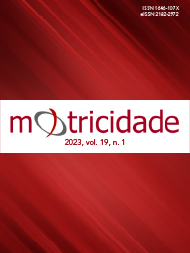The relationships between body composition, phase angle, and strength in youth athletes from Paraná
DOI:
https://doi.org/10.6063/motricidade.27834Keywords:
Youth Sports, Athletic Performance, Bioimpedance, Vertical Jump, Hand GripAbstract
The Bioimpedance provides phase angle data, and it is used to monitor athletes. Muscle strength and power are important physiological/motor characteristics in sports that involve intense movement. The aim of this study was to verify the relationships between body composition, phase angle and upper/lower limb strength in adolescent athletes from different sports. The sample consisted of 473 athletes (Male: 285 and Female: 188), with a mean age of 16.4+1.2 years. The adopted statistic was Principal Component Analysis, with analysis groups formed as General, Male and Female. The Kaiser-Meyer-Olkin and Bartlett's (p<0.01) tests showed good results to follow Principal Component Analysis. The total variance showed that the formation of components was three for General, four for Male and five for Female, where the variance explained by the Principal Component Analysis in each group was 73.9%, 78.7% and 83.1%, respectively. The phase angle is a relatively new variable when evaluating in the sports context, it proved to be important in monitoring the physical condition of adolescent athletes, where in activities that are requested, a more advantageous muscle condition is presented when muscle mass is increased, where in addition to having a good relationship with strength, and it is also related to the variables of body composition and Bioimpedance.
Downloads
Published
Issue
Section
License
The authors of submitted manuscripts must transfer the full copyright to Journal Motricidade / Sílabas Didáticas Editions. Granting copyright permission allows the publication and dissemination of the article in printed or electronic formats, and copyrights start at the moment the manuscript is accepted for publication. It also allows Journal Motricidade to use and commercialise the article in terms of licensing, lending or selling its content to indexation/abstracts databases and other entities.
According to the terms of the Creative Commons licence, authors may reproduce a reasonable number of copies for personal or professional purposes, but without any economic gain. SHERPA/RoMEO allows authors to post a final digital copy (post-printing version) of the article on their websites or on their institutions' scientific repository.


